



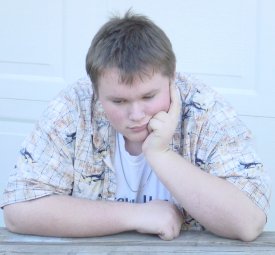
| The Levi Configuration |
| By Lawrence Morris and Jared Dwarshuis |
| January, 2004 |
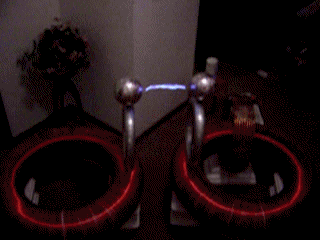 |
Let's start with a simple LC circuit. We will show that this system corresponds with a spring and mass system by using Lagrange equations. (Textbooks usually use Newton's approach for showing correspondence, as Newton's approach is more intuitive, but the Lagrange is unbeatable for solving difficult problems.)
V = 1/2 K X squared
La = T - V
We get -K X = - M X double dot
let X = a cos (wt)
then X dot = - a (w) sin (wt) and X double dot = -a (ww) cos (wt)
Substituting these back in and canceling we get K = M (ww)
then w = the square root of K/M
Now we have an expression for the angular frequency of a mass spring system.
Now let's use the same procedure to describe a series LC circuit.
La = 1/2 L Q dot squared - 1/2 (1/C) Q squared
Using the same procedure as above we get L Q double dot + Q/C = 0
let Q = a cos (wt)
Q dot = - a (w) sin (wt)
Q double dot = - a (ww) cos (wt)
Substituting and canceling we get: ww = 1/ LC
so w = 1 / sqrt LC
Since w = 2 pi frequency we can write this as frequency = 1 / 2pi sqrt LC
The upshot is that we can say that the following correspond:
1/2 M Vel sqrd ~ 1/2 L I sqrd
Q ~ -X
I ~ Velocity
C ~ 1/K
L ~ Mass
Now if we examine a two mass system of equal mass connected with a spring we will find using the Lagrange that if the mass are pulled apart and released we have w = sqrt k/m for each mass about the stationary point of the spring (also known as the center of mass). And if we have two equal mass and two equal spring (in a circle) we will get the same result about their respective centers of mass where w = sqrt k/m.
The two previous facts provide the justification for our groundless two part transformers. It says we can connect two resonant inductors (at one wavelength) with a single capacitor. Or we can connect two resonant inductors (at one wavelength) with two capacitors.
An easy-to-understand analogy of the functioning of our groundless transformers can be found with two parallel ropes and a spring. If we place the correct light spring between the two parallel ropes at a distance of 1/4th the rope length and drive just one rope to resonance at one full wavelength we will find the other rope 180 degree out of phase with its own standing wave, also at one full wavelength. At one wavelength we can place two springs on the rope with the second spring at a distance of 3/4th the rope length and this works also.
Now a Saskia's coil is like a metal ring, we can shake a point along the rim and get a standing wave without any hard reflection. So if we placed the correct light spring between two rings at a node and then drive one ring to resonance at one full wavelength we could get the other ring to resonate 180 degrees out of phase along with it. Levi's configuration is the electric version of the analogy above where we use one spring. Marsha's configuration uses two springs.
There is a lot of math to go along with all of this, but we have made some unproven assumptions along the way that need to be made consistent with current theory, so we didn't include our physics work in this paper (pending). However we will share the distilled results needed to reproduce our groundless transformers.
With Levi's configuration, use the exact same math you would use to get sparks across a single toroid, then remove one of the capacitor plates and stick it on a nude coil. (Sounds too simple to be true, but that's the way it is!)
The Marsha's secondary coil set shown was made of an odd mix of scrap box junk wire wound around cardboard running at about 800,000 hertz . We did not tune this coil - it was only made as a quick proof. You can run this coil with either one breakout point or two. We plan to build a nice set of these coils by next summer. The math for this coil deviates in that we use solenoid formula instead of toroid formula for calculating inductance and you double the top end capacitance found with the Saskia's coil math.
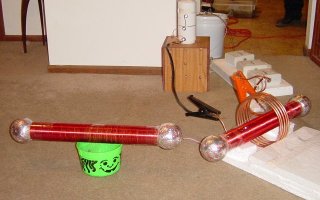
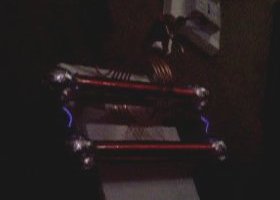
We have never built a quarter wave coil so we have not tested this but our calculations indicate that if you build a solenoid that is exactly twice as long as the solenoid you are using in your quarter wave, and then cap both ends with the same top end capacitor that you used for your quarter wave that you will have a resonant target. You may well be able to extend your effective maximum spark length using this device. The device will become a live transformer (returning fire) so you will need to place it on some sort of insulator.
Closing remarks, we have great respect for the master coilers who have shared information through this medium. We are not cavalier, we have great respect for traditional methods, we are just looking for some shortcuts to new coil designs and we are finding them.
We have included a few photos of other configurations that work, but we will not be commenting on them.
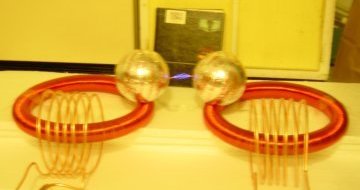
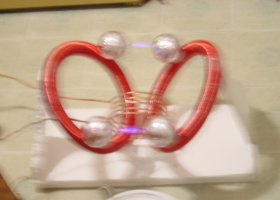
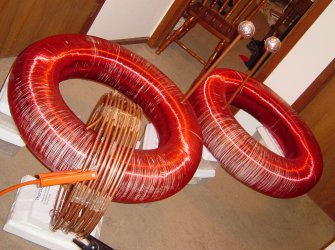
Levi's Configuration with two wavelengths. Note primary is at 45 degrees.